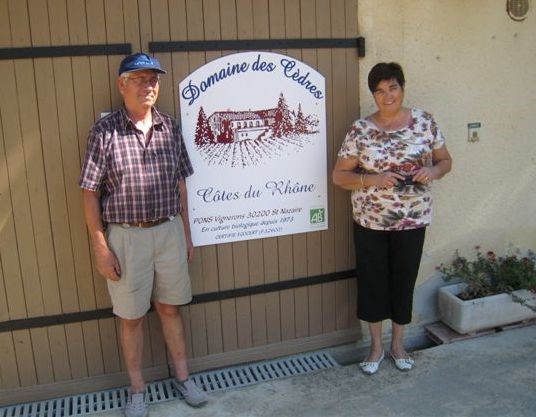
The Rhône is a wine region in the Rhone Valley in Southern France. It is divided into a northern & southern region with different rules for the two regions. The only red grape allowed in the north is Syrah. There are 10 different red grapes allowed in the south.
The southern Rhône has a Mediterranean climate (mild winters & hot summers). Drought issues are bad enough in the Rhône that limited irrigation is allowed (irrigation is regulated by EU & appellation rules). There is a large diurnal shift, so large pebbles are often grouped around the base of the vines to absorb heat during the day & then release it at night to keep the vines from getting too cool.
Cotes Du Rhônes are the most produced AOC wines in the area. They are generally designed to be lighter weight easy drinking wines which are not intended for aging.
Cotes du Rhône Villages wines are a step up (or a ring in if you think about the appellation as a dart board). Grenache is the primary grape & the wines are required to have at least 50% Grenache. They can have 20% Syrah &/or Mourvèdre combined. That leaves a maximum of 20% that can come from the other 6 grapes. The minimum alcohol is 12%, which isn’t much of an issue given the heat & Grenache’s propensity for ripeness. There is another Villages level that involves named villages, but that isn’t the case with Domaine de Cèdres.
Domaine des Cèdres was founded in 1906 & is owned by Dominique Pons & his wife Genevieve. Dominique is the

primary winemaker. They have 30 acres of vineyards planted on south facing slopes. The soil is clay & limestone with the traditional Rhône stones. They are a single vineyard producer rather than a négociant, like most Rhône producers.
The vineyards have been certified organic since 1973. They currently farm bio-dynamically, but have not been certified. The Pons were named Pioneers of Organics in 2011.
These two wines are a nice example of the difference between Cotes Du Rhônes & Cotes du Rhône Villages. You have the same producer & similar grapes, but very different wines.
Domaine des Cèdres Côte du Rhône 2014
60% Grenache, 20% Syrah, 20% Carignan This was fermented & stored in cement & enamel tanks.
This has fresh fruit flavors, especially after sitting for a while. It has medium plus acidity, medium body, medium alcohol, & medium flavor intensity. On the palate it has sour cherry, cranberry, raspberry as the primary fruits. The fruits seem slightly under ripe, not in a bad way, but very tart. There is some black pepper & more white pepper. There is also a little bell pepper & some green herbaceous quality. As it opens, there are some nice violet notes that are indicative of Syrah. The tannin is medium plus. The finish is medium plus. This is a juicy fresh red fruit wine that would be great with a burger or grilled meat.
Domaine des Cèdres Côte du Rhône Villages 2014
Older vines from higher up the slopes are picked for this wine. The blend is Grenache, Syrah, and Carignan, but I don’t have the percentages handy. The wine ages for a year in new oak.
This has medium plus acid, medium body, medium alcohol, medium flavor intensity, & a medium finish. The tannins are medium plus. There is a clear blueberry note that almost seems like a northern Rhone Syrah. There is also a slight hint of bacon fat, although is fades after it has opened up. There is still some of that dry red fruit, particularly cranberry & sour cherry that the regular Cote du Rhone has. It has a meatier taste than the CDR. This would work well with grilled or braised meat. It would be great with grilled lamb. It even us a slight mint note that would be good with lamb.
Here are a few bullet points to remember about these wines
- They are one of the earliest organic wineries in the region (certified since 1973)
- They have used bio-dynamic practices since 2003, but are not certified
- The wines are vegan friendly
- They are estate wines
- They are good picnic or grilling wines
Thanks for sharing!